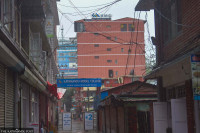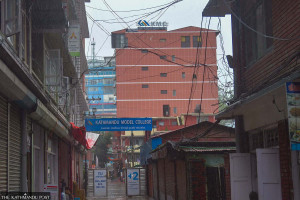Valley
Govt to amend building code
Nepal’s building construction code, currently under revision by the government, will witness amendment in about eight provisions and be implemented by mid-July, officials said.
Gaurav Thapa
A team of experts from the Department of Urban Development and Building Construction is working on amending the National Building Code (NBC), 1994 and a change in building practices will be brought about by the end of this fiscal year, Urban Development Ministry’s spokesperson Padma Kumar Mainalee told the Post. The current fiscal year ends on July 16.
Mandatory Rules of Thumb for building construction and guidelines for earthquake-resistant building are set to be revised in line with the changed context of the country, according to Parikchit Kadariya, engineer at Building Measurement Section and Health Unit of the DUDBC.
There are three sets of codes for Mandatory Rules of Thumb in the NBC: for Concrete Buildings without Masonry Fill, for Load-bearing Masonry and for Reinforced Concrete Buildings with Masonry Fill. These codes include general requirements for column size, beam size, outer wall, partition, reinforcement detailing, slab detailing et al for houses, Civil Engineer Sujan Bista said.
The 23-volume NBC also consists of two sets of guidelines for earthquake-resistant building construction—one for earthen buildings and the other for low strength masonry—which are in place to raise the seismic safety of buildings, Bista added. All these codes, including some others, are set to be redefined after they were found lacking to contain damage in the event of a powerful earthquake.
On May 18, the Ministry of Federal Affairs and Local Development had directed all municipalities and District Development Committees across the country not to issue new building permits as a stopgap measure after the Great Earthquake. The nationwide ban also extends to houses under construction (which have been directed to limit the building’s height to two storeys) and plotting of land till a new regulation is in place.
“Building codes cannot be formulated in a short span of time. Nevertheless, we will forward the amendments to the Cabinet before the stipulated date,” Kadariya said. He also informed that the revisions were part of an earlier plan and not just something done after the earthquake to fend off public ire.
Civil Engineering Consultant Sujan Dhakal said the worst problem of the NBC is that it was copied from Indian building construction standards. “Minimum standards for safe buildings vary from place to place depending on the bearing capacity of soil. They should have done a geological survey of lands in Nepal before formulating our building codes,” he said. Geologists can identify the types of structures and their sizes suitable for a fault zone during earthquakes of varying frequency and codes could have been made accordingly, he added.
Engineer Kadariya, however, refuted claims of NBC being copied from India. “An independent team of international consultants formulated our building codes after the earthquake of 1988,” he said. “They could have referred to the Indian Standards for some provisions but no compromises have been made.”
“Outdated building codes and its lax implementation were the major causes of substantial earthquake damage in the country,” Mainalee said. “Although we are facing difficulties in amending a couple of codes, changes in building practices will be evident by mid-July,” he said.




 22.07°C Kathmandu
22.07°C Kathmandu














